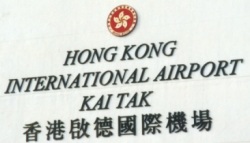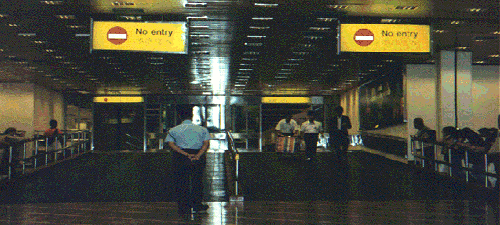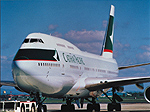| |

Aviation
Kai Tak Airport
In 1924, local businessman Sir Ho Kai and Mr. Au Tak started to reclaim land in Kowloon Bay for a speculative housing
development. The reclamation was completed, but the venture failed. The land reverted to Hong Kong Government just
at the time when thought was being given to an aircraft landing field and flying boat moorage. On Lunar New Year's
Day 1925, the first aircraft was to take off from the grass strip. The civil airport at Kai Tak was a reality.
By 1927, a RAF detachment was housed there in masthead hangars. In 1928, a crane and spillways to handle flying
boats were built, and in 1930 the first civilian airport superintendent, Mr. A.J.R. Moss was appointed.
In 1935, the first control tower and fire engine were in place. The first commercial passenger, Mr. Ong Eee-Lim,
arrived on 24th March 1936 on a mail flight from Penang and in 1937 the airport handle all of 3685 passengers.
The first tarmac runway, 457 metres long, running east-west was completed in 1939. During the Japanese occupation,
a north-south runway 1371 metres long was added and the earlier runway extended to the same length.
Commercial flight to Kai Tak resumed in September 1945. Within a few years, it was clear that major expansion of
the airport was needed. In 1954, work began on a new terminal; while in 1956, a contract was let to reclaim sixty
hectares of land in the bay to build a new 2194 metres long north-south runway. By 1965, Kai Tak was handling nearly
1 million passengers a year. In 1970s, the new runway was extended to 2541 m, and later in 1975 to 3358m, so as
to handle the new large jets like the Boeing 747 and Mcdonnell Douglas DC-10. The aircraft parking area was extended
as well from a capacity of ten planes to thirty-three. In 1976, over 4 million passengers passed through the airport
and the first cargo terminal opened.
During its sixtieth anniversary year in 1987, Kai Tak handled over 10 million passengers and half a million tonnes
of cargo. In 1995, this had grown to over 24 million passengers and nearly one and a half million tonnes cargo.
Due to the increase in demand of the airport loading, a new airport I Chap Lap Kok was come to use in 1997, and
the Kai Tai Airport was finally closed on the same day.
 

Dragon Air
In July 1985 a Boeing 737-200A took off from Hong Kong International Airport bound for Kota Kinabalu in Malaysia.
The event marked the start of a new chapter in Hong Kong's aviation history, as it was the first commercial flight
of Hong Kong Dragon Airlines, an airline which was to grow into Hong Kong's regional carrier and become known as
Dragonair.
Dragonair's fleet now comprises five wide-body A330s, two single-aisle A321s and five A320s. The airline's network
covers 26 destinations across the Asia-Pacific region including 17 in mainland China.
Cathay Pacific
Cathay Pacific Airways was founded in Hong Kong on 24 September 1946 by two enterprising adventurers, American
Roy C. Farrell and Australian Sydney H. de Kantzow. The pair had met during World War II while flying for the China
National Aviation Company over 'the Hump' - the eastern Himalayas between India and Kunming, China. The two men
shared a vision of starting a trading empire in China after the war.
The enterprise's first flight was of epic proportions. With co-pilot Bob Russell and navigator Bill Geddes-Brown,
Farrell flew Betsy, the Douglas C47, and her first cargo (morning coats and toothbrushes) to Shanghai via South
America, North Africa and the Middle East.
The plan was to operate cargo runs between China and Australia, the first being to Sydney in February 1946. With
enormous demand for consumer goods in Shanghai, and shipping in short supply, the cargo of woollen goods brought
back from Australia made a profit of around 1,000 per cent.
De Kantzow, who had earlier expressed an interest in joining the venture, met up again with Farrell at this point.
The two forged a partnership, with Farrell as the entrepreneur and de Kantzow as the organiser and chief pilot.
Their Shanghai-based import-export business flourished during 1946, and they procured a second DC3 named 'Nikki'.
Their success aroused some jealousy among local businessmen, however, and after rejecting a buyout offer, the two
partners found their freedom to operate in the city was curtailed. They moved to Hong Kong and founded Cathay
Pacific Airways.
The Swire Group
The Swire Group ('Tai Koo' in Chinese), Cathay Pacific's core shareholder since 1948, has been in Asia since 1866.
The business started in Liverpool, England in 1816, but today 90 percent of its operations are in Asia (mostly
in Hong Kong, China and Taiwan), with its other main activities in North America, Australia and the UK. The group
consists of more than 100 wholly owned or partly owned companies involved in shipping, property, retailing, insurance
and manufacturing as well as aviation.
The Group's aviation division has interests in two other airlines: Hong Kong Dragon Airlines (Dragonair) and all-cargo
carrier Air Hong Kong. It also holds interests in Hong Kong Aircraft Engineering Company and Xiamen-based Taikoo
Aircraft Engineering Company, both of which provide maintenance to Cathay Pacific and other carriers.
The Swire Group's focus on Asia reflects a confidence that Hong Kong, China and the rest of the region provide
outstanding future opportunities.
The 1990s - Looking to the Future
In addition to its passenger services, Cathay Pacific's cargo services continue to be successful, contributing
over 20 percent of the company's profit. Cathay Pacific now operates six freighters.
In 1995, the airline started work on a US$625 million headquarters located at the new Hong Kong International Airport
at Chek Lap Kok. The complex, Cathay Pacific City, is due to be completed in the middle of 1999. The new airport,
which opened on 6 July 1998, has confirmed Hong Kong as Asia's premier air hub, and guaranteed Cathay Pacific room
for extensive growth.
Cathay Pacific has also maintained investments in a number of associate airlines and has expanded its interests
in a number of airline-related service companies, including catering, ramp handling services and cargo terminal
security services and laundry. These investments provide Cathay Pacific with a strong base from which to expand
into the next century.
It is no coincidence that Cathay Pacific's development parallels that of Hong Kong. As the airline flies into the
21st century, it shares with its home excellent opportunities for continued success.

|